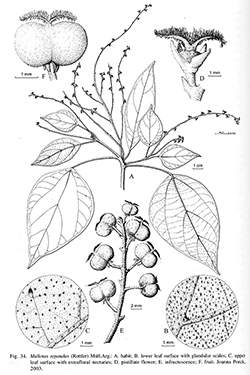e-Flora of Thailand
Volume 8 > Part 2 > Year 2007 > Page 425 > Euphorbiaceae > Mallotus
32. Mallotus repandus (Rottler) Müll.Arg.
Linnaea 34: 197. 1865; Hook.f., Fl. Brit. Ind. 5: 442. 1887; Gagnep. in Lecomte, Fl. Indo-Chine 5: 365. 1925; Airy Shaw, Kew Bull. 26: 301. 1972; Whitmore, Tree Fl. Malaya 2: 114. 1973; Welzen, Slik & Bollendorff in Welzen et al., Thai Forest Bull., Bot. 28: 107. 2000; S.E.C.Sierra, Welzen & Slik, Blumea 50: 234 fig. 5, map 3. 2005.— Croton repandus (‘repandum’) Rottler, Ges. Naturf. Freunde Berlin Neue Schriften 4: 206. 1803.— Rottlera repanda (Rottler) Scheff., Ann. Mus. Bot. Lugduno-Batavi 4: 124. 1869. Fig. 34.
Accepted Name : This is currently accepted.
Synonyms & Citations :
Description : Scandent shrub or woody climber. Indumentum of simple and stellate hairs, glandular scales orange. Stipules early caducous. Leaves alternate; petiole 1–7.7 cm long; blade ovate (to panduriform), 2.8–11.3 by 2.3–9 cm, length/width ratio 1.2–1.3, drying dark green, base rounded to truncate, slightly peltate up to 2 mm, margin entire to somewhat denticulate with few glandular teeth, apex acuminate to cuspidate, upper surface glabrescent, mainly hairy on nerves, with (2)3(4) pairs of black extrafloral nectaries submarginally in lower third, lower surface densely hairy, venation triplinerved. Inflorescences terminal and axillary, single to usually groups of up to 4, not or somewhat branching. Staminate inflorescences up to 20 cm long, side branches up to 9 cm long; flowers in groups of up to 6 per node; bracts triangular, 1.1–1.5 by 0.7–1 mm. Staminate flowers 4–6 mm in diam., yellowish-white to yellow, scented; pedicel 3–3.5 mm long; sepals 3 or 4, elliptic, 2.8–3.2 by 1.1–2 mm; stamens ca 50, filaments 1.8–2.2 mm long, anthers ca 0.6 mm long. Pistillate inflorescences up to 12 cm long; bracts triangular, 1–1.6 by ca 1 mm. Pistillate flowers ca 6 mm in diam., yellow, scented; pedicel 1–2 in fruit)mm long; calyx 3- or 4-lobed, ca 3 mm long, lobes ovate, 2.3–2.8 by 1–1.5 mm; ovary 2-locular, 1–1.2 by 1.6–2.4 mm, dull light greenish, densely hairy, no spines; style 0.3–0.4 mm long, brown; stigmas 3–4 mm long, brown. Fruits lobed capsules, ca 9.5 by 5 mm, densely hairy, without spines, column 2–3 mm long. Seeds not seen.
Thailand : NORTHERN: Chiang Mai (Doi Chiang Dao), Chiang Rai (Doi Luang), Phrae (Hue Kamui); NORTH-EASTERN: Loei (Phu Luang), Khon Kaen (Pha Bhraung Cave); EASTERN: Nakhon Ratchasima (Pak Thongchai); SOUTH-WESTERN: Kanchanaburi (Sangkhla Buri), Ratchaburi (Ban Pong), Prachuap Khiri Khan (Pranburi); CENTRAL: Saraburi (Sam Lan), Krung Thep Maha Nakhon (Bangkok) (Wat Sing); SOUTH-EASTERN: Sa Kaeo (Wattana), Chon Buri (Si Racha, Tung Brong), Chachoengsao; PENINSULAR: Surat Thani (Ko Nong, Ko Samui), Yala (Betong).
Distribution : W Peninsular India (type?), Sri Lanka to Taiwan and the Philippines, scattered throughout Malesia (absent from Borneo) to Australia and New Caledonia.
Ecology : Usually in disturbed places like thickets, along roads, along streams in evergreen and especially mixed deciduous forests; soil: calcareous, limestone bedrock; 150–550 m alt.
Vernacular : Makai khruea (มะกายเครือ), mapop khruea (มะปอบเครือ)(Northern); naeo nam (แนวน้ำ)(Prachuap Khiri Khan); pho khan (โพคาน)(Chai Nat); kurapia (กุระเปี้ยะ)(Pattani); yiao maeo thao (เยี่ยวแมวเถา)(Narathiwat); yiao maeo (เยี่ยวแมว)(Peninsular); ku-ko-bue-ya (กูเก๊าะบือยะ), ku-ko-mu-ya (กูเก๊าะมูยะ)(Malay-Narathiwat).

